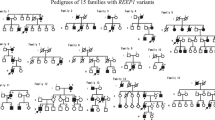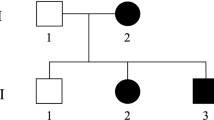Abstract
Autosomal dominant familial spastic paraplegia (FSP) is a degenerative disorder of unknown aetiology characterized by a progressive spasticity of the legs. Three families with autosomal dominant FSP of early onset were analysed in linkage studies using highly polymorphic microsatellite markers. Close linkage to a group of markers on chromosome 14q (maximum multipoint lodscore z=10) was observed in one family. This chromosome 14q candidate region was entirely excluded in the two other families, providing evidence of genetic heterogeneity within a homogeneous clinical form of FSP.
This is a preview of subscription content, access via your institution
Access options
Subscribe to this journal
Receive 12 print issues and online access
$209.00 per year
only $17.42 per issue
Buy this article
- Purchase on Springer Link
- Instant access to full article PDF
Prices may be subject to local taxes which are calculated during checkout
Similar content being viewed by others
References
Seeligmüller, A. Sklerose der seitenstrange des Rückenmarks bei 4 Kindern derselben Familie. Dtsch. med. Wochenschr. 2, 185–186 (1876).
Strümpell, A. Beiträge zur Pathologie des Rückenmarks. Arch. Psychiatr. Nervenkr. 10, 676–717 (1880).
Sutherland, J.M. Familial spastic paraplegia, in Handbook of Clinical Neurology 22 (eds Vinken, P.J. & Bruyn, G.W.) 421–431 (North Holland Publishing Company, Amsterdam, 1975).
Holmes, G.L. & Shaywitz, B.A. Strümpell's pure familial spastic paraplegia: Case study and review of the literature. J. Neurol. Neurosurg. Psychiatry. 40, 1003–1008 (1977).
McKusick, V.A. . in Mendelian Inheritance in Man (9th edn) 864 (The Johns Hopkins University Press, Baltimore and London, 1990).
Keppen, L.D. et al. Biological heterogeneity in X-linked spastic paraplegia. Am. J. hum. Genet. 41, 933–943 (1987).
Harding, A.E. Hereditary “pure” spastic paraplegia: a clinical and genetic study of 22 families. J. Neurol. Neurosurg. Psychiatry 44, 871–883 (1981).
Harding, A.E. Classification of the hereditary ataxias and paraplegias. Lancet 1, 1151–1155 (1983).
Schady, W. & Sheard, A. A quantitative study of sensory function in hereditary spastic paraplegia. Brain 113, 709–720 (1990).
Weissenbach, J. et al. A second-generation linkage map of the human genome. Nature 359, 794–801 (1992).
Boustany, R-M.N. et al. The autosomal dominant form of “pure” familial spastic paraplegia: Clinical findings and linkage analysis of a large pedigree. Neurology 37, 910–915 (1987).
Claudio, J.O. et al. Genetic linkage mapping of hereditary spastic paraplegia. Am. J. hum Genet. 51, A361 (1992).
van Deutekom, J., van den Boorn, N., Padberg, G.W. & Frants, R.R. Linkage analysis in a Dutch family with “pure” familial spastic paraplegia (FSP). Am. J. hum. Genet. 52, A375 (1992).
Church, G.M. & Kieffer-Higgins, S. Multiplex DNA sequencing. Science 240, 185–188 (1988).
Hazan, J., Dubay, C., Pankowiak, M.-P., Becuwe, N. & Weissenbach, J. A genetic linkage map of human chromosome 20 composed entirely of microsatellite markers. Genomics 12, 83–189 (1992).
Vignal, A. et al. A non-radioactive multiplex procedure for genotyping of microsatellite markers, in Methods in Molecular Genetics 1, (ed. Adolph, K.W., in the press, 1993).
Lathrop, G.M., Lalouel, J.M., Julier, C. & Ott, J. Multilocus linkage analysis in humans: Detection of linkage and estimation of recombination. Am. J. hum. Genet. 37, 482–498 (1985).
Vance, J.M. Hereditary motor and sensory neuropathies. J. med. Genet. 28, 1–5 (1991).
Kenwrick, S. et al. Linkage studies of X-linked recessive spastic paraplegia using DNA probes. Hum. Genet. 73, 264–266 (1986).
Suthers, G.K. & Davies, K.E. Phenotypic heterogeneity and the single gene. Am. J. hum. Genet. 50, 887–891 (1992).
Polo, J.M., Calleja, J., Combarros, O. & Berciano, J. Hereditary “pure” spastic paraplegia: a study of nine families. J. Neurol. Neurosurg. Psychiatry 56, 175–181 (1993).
Author information
Authors and Affiliations
Rights and permissions
About this article
Cite this article
Hazan, J., Lamy, C., Melki, J. et al. Autosomal dominant familial spastic paraplegia is genetically heterogeneous and one locus maps to chromosome 14q. Nat Genet 5, 163–167 (1993). https://doi.org/10.1038/ng1093-163
Received:
Accepted:
Issue Date:
DOI: https://doi.org/10.1038/ng1093-163
This article is cited by
-
Genome-Wide Analyses of Working-Memory Ability: A Review
Current Behavioral Neuroscience Reports (2014)
-
Hereditary spastic paraplegia: clinico-pathologic features and emerging molecular mechanisms
Acta Neuropathologica (2013)
-
Hereditary spastic paraplegia
Current Neurology and Neuroscience Reports (2006)
-
Narrowing of the critical region in autosomal recessive spastic paraplegia linked to the SPG5 locus
Neurogenetics (2004)
-
Early onset autosomal dominant spastic paraplegia caused by novel mutations in SPG3A
Neurogenetics (2004)



